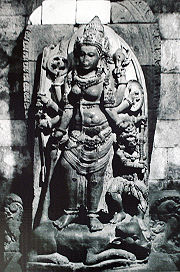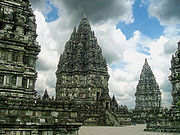
Loro Jonggrang (Legend)
Encyclopedia


Central Java
Central Java is a province of Indonesia. The administrative capital is Semarang. It is one of six provinces on the island of Java.This province is the province of high Human Development in Indonesia and its Points Development Index countries is equivalent to Lebanon. The province of Central Java...
telling the story of love and betrayal, the knight and the cursed princess. It also explains the mythical origin of Ratu Boko palace
Ratu Boko
Ratu Boko is an archaeological site known to modern Javanese as Kraton Ratu Boko or Ratu Boko's Palace. Ratu Boko is located on a plateau, about three kilometres south of Lara Jonggrang Prambanan temple complex in Yogyakarta Indonesia...
, Sewu temple
Candi Sewu
Sewu is an 8th-century Buddhist temple located 800 meters north of Prambanan in Central Java. Candi Sewu is actually the second largest Buddhist Temple in Central Java after Borobudur. Candi Sewu predates "Loro Jonggrang"...
, and the Durga
Durga
For the 1985 Hindi Film of Rajesh Khanna see DurgaaIn Hinduism, Durga ; ; meaning "the inaccessible" or "the invincible"; , durga) or Maa Durga "one who can redeem in situations of utmost distress" is a form of Devi, the supremely radiant goddess, depicted as having eighteen arms, riding a lion...
statue in Prambanan
Prambanan
Prambanan is a ninth century Hindu temple compound in Central Java, Indonesia, dedicated to the Trimurti, the expression of God as the Creator , the Sustainer and the Destroyer...
temple compound.
The Story
The legend tells the story about two ancient and neighbouring kingdoms in Java, Pengging and Boko.Pengging was prosperous, and wisely ruled by its king Prabu Damar Moyo who had a son named Bandung Bondowoso. By contrast, Boko was ruled by a cruel man-eating giant named Prabu Boko, supported by another giant Patih Gupolo. Despite his unpleasant nature, Prabu Boko had a beautiful daughter named Loro Jonggrang.
The story relates that Prabu Boko desired to expand his kingdom, and so began training an army and raising taxes for an invasion of Pengging. His forces launch a surprise attack on Pengging, and the ensuring war causes devastation and famine on both sides. In order to defeat the invader, Prabu Damar Moyo sends his son Bandung Bondowoso to fight Prabu Boko. After a furious battle, Prabu Boko is killed by the prince's supernatural powers. His assistant, the giant Patih Gupolo, leads his armies away from the battlefield in defeat.
Returning to Boko Palace, Patih Gupolo tells princess Loro Jonggrang of the death of her father. The princess is heartbroken, but before she can recover from her grief the Pengging army besieges and captures the palace. Prince Bandung Bondowoso is mesmerized by the beauty of the mourning princess and propose marriage, but his offer is swiftly rejected. Bandung Bondowoso insists on the union, and finally Loro Jonggrang agrees on two impossible conditions: first the prince must build a well named Jalatunda, and second, he must construct a thousand temples in only one night.
The lovestruck prince agrees, and immediately starts work on the well. Using his supernatural powers once again, the prince swiftly finishes construction and proudly displays his work for the princess. As a trick, she urges him to enter the well and when he does so, Patih Gupolo piles stones into it and buries him alive. With great effort Bandung Bondowoso escapes, but his love for the princess is so strong that he forgives her the attempt on his life.
To fulfill the second condition, the prince enters into meditation and conjures up a multitude of demon spirits from the earth. With their help he builds the first 999 temples and starts work on the final one. To thwart his efforts the princess and her maids light a fire in the east and begin pounding rice, a traditional dawn activity. Fooled into thinking the sun is about to rise, the spirits flee back into the earth leaving the last temple unfinished.
The prince is furious when he learns of this deception, and places a curse on Loro Jonggrang which turns her into a stone statue. In this way she herself becomes a feature of the final temple, completing its construction and fulfilling the conditions for their marriage.
The Interpretation
This legend is a local popular folklore that connects and explains the supernatural origin of Central Java's famous archaeological sites; such as of the Ratu Boko palaceRatu Boko
Ratu Boko is an archaeological site known to modern Javanese as Kraton Ratu Boko or Ratu Boko's Palace. Ratu Boko is located on a plateau, about three kilometres south of Lara Jonggrang Prambanan temple complex in Yogyakarta Indonesia...
, the Durga
Durga
For the 1985 Hindi Film of Rajesh Khanna see DurgaaIn Hinduism, Durga ; ; meaning "the inaccessible" or "the invincible"; , durga) or Maa Durga "one who can redeem in situations of utmost distress" is a form of Devi, the supremely radiant goddess, depicted as having eighteen arms, riding a lion...
statue in northern cella/chamber of the main Prambanan
Prambanan
Prambanan is a ninth century Hindu temple compound in Central Java, Indonesia, dedicated to the Trimurti, the expression of God as the Creator , the Sustainer and the Destroyer...
shrine, and the Sewu temple complex
Candi Sewu
Sewu is an 8th-century Buddhist temple located 800 meters north of Prambanan in Central Java. Candi Sewu is actually the second largest Buddhist Temple in Central Java after Borobudur. Candi Sewu predates "Loro Jonggrang"...
nearby. Although the temples itself dated from circa 9th century, the legend was composed in later times, probably during Mataram Sultanate
Mataram Sultanate
The Sultanate of Mataram was the last major independent Javanese empire on Java before the island was colonized by the Dutch. It was the dominant political force in interior Central Java from the late 16th century until the beginning of the 18th century....
era.
According to tradition, this thousandth temple is part of the Sewu temple compound (Sewu means "thousands" in Javanese), and the Princess is the image of Durga
Durga
For the 1985 Hindi Film of Rajesh Khanna see DurgaaIn Hinduism, Durga ; ; meaning "the inaccessible" or "the invincible"; , durga) or Maa Durga "one who can redeem in situations of utmost distress" is a form of Devi, the supremely radiant goddess, depicted as having eighteen arms, riding a lion...
in the north cell of the Shiva temple at Prambanan, still known as Loro Jonggrang or Slender Virgin.
Another interpretation mentioned that this legend could be a collective but vague local memory about past historical events that happened in the area, which staged around the 9th century wrestle of power between Sailendra
Sailendra
Sailendra is the name of an influential Indonesian dynasty that emerged in 8th century Java.The Sailendras were active promoters of Mahayana Buddhism and covered the Kedu Plain of Central Java with Buddhist monuments, including the world famous Borobudur.The Sailendras are considered to be a...
and Sanjaya dynasty
Sanjaya Dynasty
The Sañjaya Dynasty was an ancient Javanese dynasty that ruled the Mataram kingdom in Java during first millennium CE. The dynasty was an active promoter of Hinduism in ancient Java.-Origin and formation:...
for control on Central Java. King Boko is probably inspired by the King Samaratungga
Samaratungga
Samaratungga was the head of the Sailendra dynasty who ruled Central Java and Srivijaya in the 8th and the 9th century. He was the successor of King Indra, and his name was mentioned in Karangtengah inscription dated 824 CE as the constructor of a sacred buddhist building called Venuvana to place...
of Sailendra dynasty, Bandung Bondowoso is Rakai Pikatan
Rakai Pikatan
Rakai Pikatan was a king of the Sanjaya dynasty Medang Kingdom in Central Java who built the Prambanan temple, dedicated to Shiva, which was completed in 856 AD....
, a prince of Sanjaya dynasty, and Loro Jongrang is Pramodhawardhani, wife of Rakai Pikatan and the daughter of Sailendran king. The actual historical event was probably the contest of power between Sailendran heir, Balaputradewa against his sister Pramodhawardhani with aid of her husband Rakai Pikatan which led to Pikatan as the victor, thus ending the Sailendran rule on Central Java.

